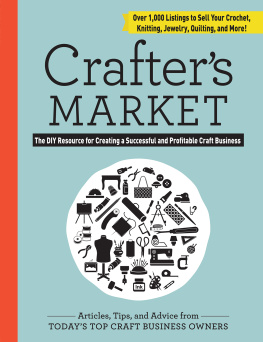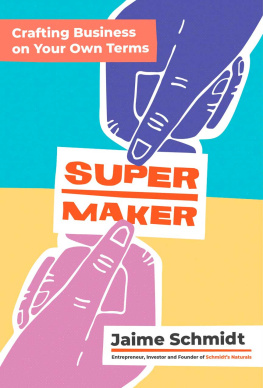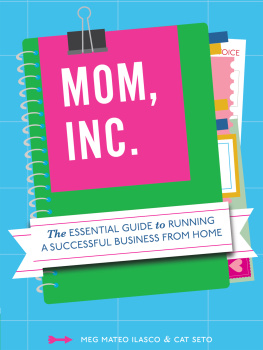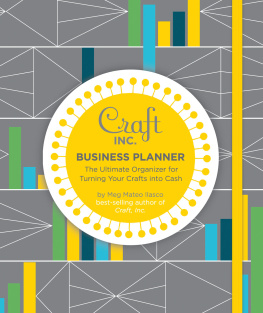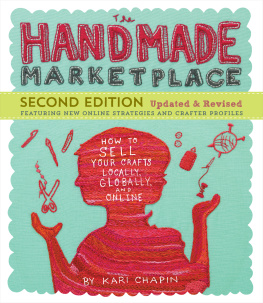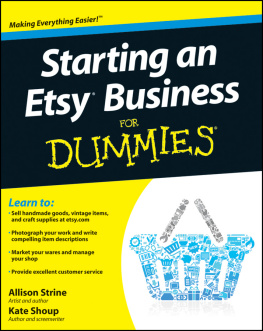Craft INC.
Revised Edition
The Ultimate Guide to Turning Your
Creative Hobby into a Successful Business
Meg Mateo Ilasco

Text copyright 2007, 2011 by Margaret Mateo Ilasco.
All rights reserved. No part of this book may be reproduced in any form without written permission from the publisher.
ISBN 978-1-4521-2852-8
The Library of Congress has cataloged the previous edition as follows:
Ilasco, Meg Mateo.
Craft, inc. : the ultimate guide to turning your creative hobby into a successful business / Meg Mateo Ilasco. Rev. ed
p. cm.
Includes index.
ISBN 978-1-4521-0141-5
1. New business enterprisesManagement. 2. Small businessManagement. 3. Home-based businessesManagement. 4. Self-employed. 5. Hobbies. I. Title.
HD62.5.I39 2011
745.5068 dc22
2010053576
Designed and Illustrated by Sarah Meyer
Cover design by THUSSFARRELL
Typeset by Happenstance Type-O-Rama
This book was typeset in Dalliance, Fling, and Gotham 8/11.5
Chronicle Books
To my craft muse and mom,
Dely
Contents
Introduction
Introduction
If you have ever muttered the words I wish I could make a living doing [ insert artistic passion here ], you certainly are not alone. For a creative individual like yourself, trapped in a dour cubicle transcribing letters for your boss or nursing achy feet after waiting on tables, its probably a mantra you recite every day. But while your coworkers are eyeing the corner office, your goals lie elsewhere. You ponder throw pillow design possibilities instead of sales reports. Your cubicle contraband provides temporary fodder for your inventivenesscoasters made of paper clips, anybody? With your finger poised over the quit button, you yearn for an escape. For now, starting your own creative business may be nothing more than an idea, but its absolutely possible to turn what you do for fun into what you do to get paid.
These days, it isnt at all surprising to ask a gal where she got the baubles draped around her neck, and find her response paired with a handshake and business card. The urge to make stuff, combined with growing public interest in design and the renewed popularity of traditional art forms like knitting and sewing, has made it more appealing than ever to turn a craft into a business. But how exactly do you make the transition from hobbyist to professional crafter? It might be hard to imagine making this move, especially when youre already holding down a day job to pay the utility bills, school loans, and rent, not to mention spending time with your friends and family. The good news is that with planning and determination you can achieve more than you ever thought possible.
Acting on your desire to earn money from your craft can be an anxiety-filled proposition. Consider Craft, Inc. your guide as you prepare for this impending mental and belt-tightening shift. Bridging the gap between your creative vision and the reality of starting a business, this guide provides advice on putting together a business plan, creating a line of goods, outsourcing your production, selling your wares in the wholesale or retail market, and getting editorial coverage in magazines. In addition, to serve as your muses, established indie crafters and designers are interviewed throughout.
The road to making your craft a profitable business can be bumpy. It might take time for your unique style to catch on; even if you become the darling of the indie design scene and gain instant fans, it doesnt necessarily mean youll turn a profit this year, or next year. Building a successful creative business requires many elements. Some elements are intangiblelike luck and timingand some you can controllike working hard and arming yourself with knowledge. No one can predict or prepare you for every obstacle that will come your way, but in Craft, Inc. youll learn about potential pitfalls and ways to protect your business.
It wont be long until you experience the unbeatable joy of making that first sale, the empowerment of seeing your name on your very own business cards, and the thrill of opening your favorite glossy and spotting your work gracing its pages. Suddenly, youll find that the creative business dream youve slept on for years will now keep you up at night, giddy with excitement. And while your old career simply put food on the table, your new crafting career will feed your soul. With Craft, Inc . on your side, you will be prepared to successfully take this creative leap!

CHAPTER 1
Your Creative Mind
D o you know the extent of your creative potential? Its hard to gauge if you havent given it any room to grow and develop. Perhaps youre insecure about your talents or indecisive about what crafts to pursue. Or maybe your creative alter ego only appears on special occasions, just in time to create hand-spun woolens for the holidays. How do you respond when thoroughly impressed friends say, You should sell this!? Do you allow yourself excuses to avoid going after this dream? Maybe youve abandoned your craft for a more conventional career and you feel there isnt enough room left in your schedule, or perhaps youre afraid of failure. This chapter will help you explore, reclaim, or recharge your creative potential. And because you cant be creative without creating, youll be clued in to the perseverance it takes to turn craft ideas into craft business reality. So gather courage, and your crochet hooks, and get ready to explore the depths of your talents!
Creative Mythology
For months, or maybe even years, the prospect of becoming a creative- business owner has been sitting patiently inside your head. The part of you that craves stability demands that you stay away from a new career path that you may find intimidating, mysterious, or unpredictable. Since its not easy to dismiss fears and anxieties completely, why not manage them? Lets start by acknowledging five common myths that many aspiring artists subscribe to; youll probably recognize yourself in some, if not all, of them.
MYTH To be an artist you should have a background in fine arts or design. In this guide, we use the word artist in the broadest sense of the term. In essence, an artist is anyone imbued with healthy doses of curiosity and creative urges. You dont need a degree in art or design to qualify as a real artist. You can be a naturally creative person independent of your educational background. Some of the most successful artists are largely self-taught in their discipline and lack an artistic background or formal training. If this is your situation, it simply means that your creative education will be on an as-needed basis. After all, Tadao Ando, who began practicing architectural design with neither a degree nor training, was awarded the Pritzker Architecture Prizethe worlds highest honor in architecturein 1995.
MYTH Im too old to tap into my creativity and start my own creative business. Its never too late to discover or rediscover your creative talents. Tapping into your creativity is a lifelong process, whether you realize it at age eight or forty-seven. Maybe youll have to give up being on the 30 Designers Under 30 list, but there are several things you gain with age: more life experiences, greater understanding of your likes and dislikes, and the ability to clearly articulate your values in your work. In fact, if you are at retirement age, you probably have more free time than most people to pursue a business. Try not to worry about the time that has already passed; just focus on the time ahead. You can create a strong body of work in a relatively short period of time.


